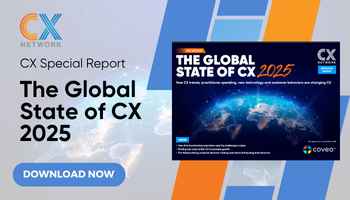Using data, technology and creativity for meaningful customer connections
Deloitte’s Perrine Masset explains how to creating meaningful customer connections with data and technology without stifling creativity
Add bookmarkListen to this content
Audio conversion provided by OpenAI

At the nexus at which CX and marketing collide, effective customer engagement has traditionally resulted from human ingenuity and creativity, driven by passion for the brand and product. As more sophisticated tools have emerged to assist CX and marketing, this work has become more focused, measurable and efficient.
However, Perrine Masset (pictured below), partner at Deloitte Digital, says these tools threaten to constrain creativity in the long-term and the passion and creativity that previously tied this work together is now stifled by process. The solution is for marketing and CX teams to clarify their value and articulate their purpose.
Drawing on more than 12 years of experience in digital marketing and direct to consumers (DTC) transformation, Masset tells CX Network how businesses can strike a balance between passion and process, add muscle to their strategy and operations and re-introduce the human touch to new tech to fully unlock creativity.
Don't miss any news, updates or insider tips from CX Network by getting them delivered to your inbox. Sign up to our newsletter and join our community of experts.
CX Network: Your work has recently led you to explore the relationship between CX and marketing, specifically how marketing was previously driven by creative, but is now required to bring data and tech into the process. What do you see happening?
 Perrine Masset: Over recent years, marketing has undergone a profound transformation, moving away from its traditional creative-centric approach to embrace data-driven strategies and technological advancements. This shift is directly tied to the increasing emphasis on delivering exceptional CX, with metrics like net promoter score (NPS) taking center stage as indicators of success and trust-building.
Perrine Masset: Over recent years, marketing has undergone a profound transformation, moving away from its traditional creative-centric approach to embrace data-driven strategies and technological advancements. This shift is directly tied to the increasing emphasis on delivering exceptional CX, with metrics like net promoter score (NPS) taking center stage as indicators of success and trust-building.
I see modern marketing teams evolving into internal influencers, championing the voice of the customer, driving innovation and – sometimes – disruption within their organizations. They are at the forefront of adopting new technologies and methodologies, constantly pushing boundaries to optimize customer engagement.
However, despite significant investments in data platforms and MarTech tools, a key challenge remains: ‘How do I effectively leverage these resources...?’
The stark reality is that I see a lot of clients with considerable volumes of data remaining untapped and with a significant percentage of MarTech tools underutilized. Here at Deloitte, our own research in spring 2024 confirmed an average utilization rate of 56.5 percent.
This underutilization represents a substantial loss of value. With mounting economic pressures, a lot of organizations I work with are shifting their focus towards maximizing the value of existing technology investments instead of procuring additional tools.
Our clients are also exploring alternative models like "tech as a service" and composable technology stacks to keep costs down while remaining agile.
Amidst this landscape, automation and generative AI stand out as areas where organizations are actively experimenting to free up team capacity and streamline operations, which is very top of mind at the moment.
Ultimately, we live in the most data-rich, technology-enabled marketing landscape ever, and that is hugely exciting. However, we must ensure that the relationship between data, technology and creativity strives for the same goal: creating meaningful connections with customers at every step of the journey.
We can’t let ourselves get caught up in bureaucracy and water down those connections.
CX Network: How can businesses strike the necessary balance and ensure the new tech tools at their disposal don’t stifle creativity?
Perrine Masset: I think that many organizations get caught in the trap of prioritizing process over passion, losing sight of the creativity that fuels brand differentiation and resonates with audiences. To re-ignite that spark, brands, in my opinion, need to make sure those tools are here to enhance, not replace, creativity. Getting the process right is fundamental, but it must be in aid of getting back to that passion which drives marketing.
To do that, I think marketing teams need to clarify their charter, articulating their marketing function's purpose, value proposition and target audience. This shared understanding can then act as a north star for decision-making and reinforce the importance of creativity in achieving those goals. I am often surprised at how many marketing leaders lack this clarity.
Once it is defined, elevate creativity and its role in your modern marketing organization. Explicitly position creativity as a core competency within the marketing function and showcase how it contributes to business outcomes.
I think embedding creativity is a daily and conscious practice. You can encourage a culture of creativity by allocating dedicated time for brainstorming, ideation and exploring new approaches. This could involve regular workshops, innovation sprints or simply encouraging "creative breaks" in the workday.
At Deloitte Digital, we love to champion the "organizing idea" concept: for every campaign or project, we emphasize the importance of a central, unifying creative idea.
This encourages teams to think beyond execution and focus on the big idea that will truly resonate with the target audience.
Lastly, recognizing and rewarding creative thinking can go a long way. This acknowledges individual contributions and reinforces the value placed on creativity throughout the organization.
I love building cross-functional teams composed of individuals with diverse perspectives, backgrounds and expertise. This cross-pollination of ideas can lead to unexpected solutions and spark fresh creativity, and technology totally has a place in that ideation process. The truth is that striking a balance between passion and the process is an ongoing journey that organizations must continuously monitor. At the end of the day, tools are just tools. They need to be at the service of your overarching marketing goals.
CX Network: With generative AI it is now possible to hyper-personalize content to small and individual customer groups. How do you see this capability developing over 2025?
Perrine Masset: While the potential of hyper-personalization is undeniable, I have seen organizations often get caught up in the race to produce more content, overlooking the importance of a strategic and holistic approach.
Generating personalized content is, I believe, only half the battle. Equally crucial is ensuring that every piece of content, regardless of its target audience, adheres to high standards of quality, relevance, compliance and measurability. It is also essential to consider the necessity of the content – is it truly adding value to the customer journey?
When it comes to generative AI, many of our clients are taking a measured approach, initially focusing on automating back-end tasks such as content tagging, versioning, and compliance. This allows them to experience efficiency gains while addressing ethical and IP concerns associated with using AI for creative ideation.
While adoption is increasing, widespread scaling of generative AI is still contingent on data quality and organizational maturity, which is still a work in progress for many brands. As businesses, we are experimenting, piloting, yes, but most of those pilots are not scaling. In our last quarterly state of generative AI report, we learned that the vast majority of businesses – as many as 70 percent – had only moved 30 percent or less of their experiments into production.
Despite existing hurdles, early successes are building confidence and driving broader adoption. I believe that 2025 will likely see generative AI scaling across various organizational functions as companies better understand their capabilities and how to mitigate potential risks.
CX Network: Aside from using generative AI to conduct extensive A/B testing, what other methods can brands adopt to test and confirm the level of engagement their content is achieving?
Perrine Masset: To accurately assess content engagement, I always encourage my clients to shift their focus from isolated metrics to the bigger picture of customer experience. Trust, for instance, can be a key performance indicator, reflecting your brand's character, transparency and capability.
I also believe that effective content measurement demands intentional, selected content creation and, as boring as it sounds, a robust governance framework:
- Upstream: Integrate quality control throughout your content supply chain and leverage tools like LLMs to automate compliance checks and streamline approvals, ensuring only high-quality content advances.
- Downstream: Proactively monitor your brand's online presence using technology to identify potential issues early on. This allows for timely intervention and protects your brand reputation.
By viewing content through the lens of customer trust and implementing a robust governance process, organizations can ensure your content is not only engaging but also contributes to a positive and trustworthy brand experience.
CX Network: In your opinion, how should CX collaborate with marketing to ensure creatives are hitting the mark with customers?
Perrine Masset: Marketing teams face mounting pressure to deliver both immediate and long-term value. To achieve this, CX integration is non-negotiable in my opinion.
Marketing functions must move from siloed operations to holistic accountability by evolving beyond their traditional focus on campaigns and channels to assume responsibility for the overall customer experience.
The power of the organizing idea that I referred to earlier can harness creative concepts as a guiding light, aligning teams across marketing, technology and customer care towards a shared vision of a seamless customer journey.
Many of our clients are shifting their operating model to better align to how customers are interacting with their brand. As such, marketing can become a unifying force within the organization and bring simplicity back to the way we work.
Quick links
- 3 steps to AI success for 2025
- Transforming CX at Zurich Insurance Group
- How to save CX according to Jim Tincher
Special Report: The Global State of CX

Tenth annual flagship report. AI has transformed CX, raising expectations with investment in AI for CX automation, machine learning, and conversational AI now a top priority. Download the Global State of CX to learn how the industry is preparing for the new AI first future.
Download Now
































